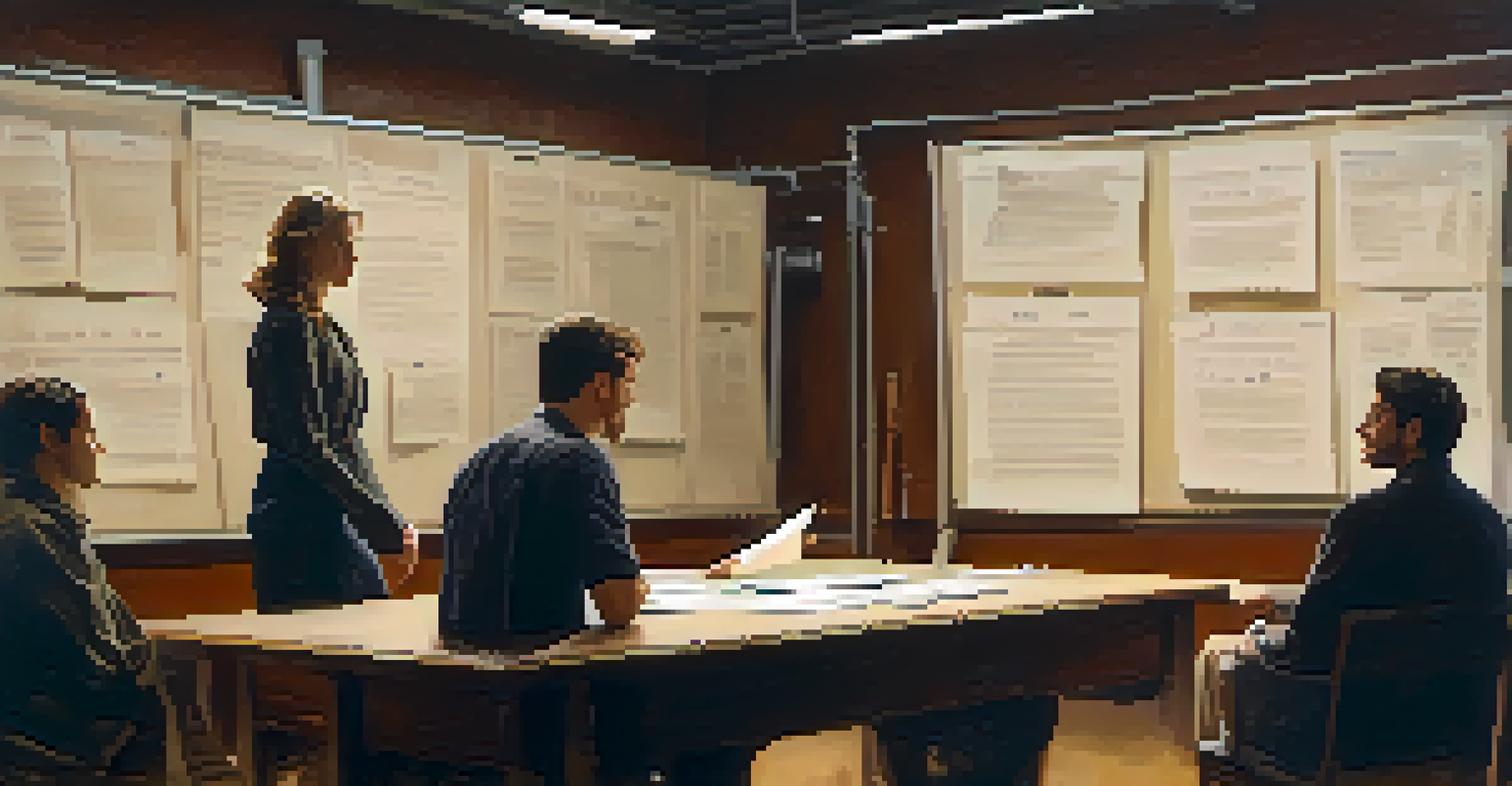How Casting Directors Shape On-Screen Chemistry Among Actors

Understanding On-Screen Chemistry and Its Importance
On-screen chemistry refers to the palpable connection between actors that captivates audiences. It's that spark that makes you believe in a couple's love story or feel the tension in a dramatic scene. Without it, even the best-written scripts can fall flat, making the casting director's role crucial in the filmmaking process.
Chemistry is not just a factor in acting, it’s a vital component that can make or break a performance.
Casting directors are tasked with finding not just talented actors but those who can create a compelling dynamic with their co-stars. This requires a keen eye for personality types, acting styles, and how different performers may interact. When they succeed, they elevate the film or series to new heights, engaging viewers on an emotional level.
Think of it like a dance; if the partners don’t move in sync, the performance loses its magic. A casting director must ensure that the actors they select can harmonize beautifully, creating an on-screen experience that feels authentic and relatable.
The Casting Process: Finding the Right Pairing
The casting process begins with thorough auditions, where directors observe how actors interact with one another. This is where the magic often happens; the chemistry can be either electric or non-existent. Casting directors often employ improvisation during auditions to see how actors respond to each other's energy and dynamics.

By creating scenarios where actors must react to one another, casting directors can spot those genuine connections that draw viewers in. For instance, two actors may have impeccable individual skills, but it’s their chemistry that ultimately seals the deal. It’s akin to a puzzle; each piece must fit perfectly to create a complete picture.
On-Screen Chemistry Enhances Stories
The connection between actors is crucial for making narratives engaging and relatable.
In essence, casting directors are not just filling roles but crafting relationships that will resonate with the audience. Their ability to identify those special pairings can make or break a film, turning a good story into a memorable experience.
The Role of Chemistry Reads in Casting Decisions
Chemistry reads are a vital step in the casting process where two or more actors are brought together to perform a scene. This allows casting directors to evaluate how the actors connect in real time. It’s during these moments that the authenticity of their interactions becomes evident, providing crucial insight into their potential on-screen partnership.
The best actors are not only skilled at their craft but also able to connect deeply with their co-stars.
During a chemistry read, directors may observe subtle nuances—like eye contact, body language, and even unspoken moments—that indicate a natural connection. These elements can be the difference between a believable relationship and one that feels forced. It’s a bit like meeting someone new; you can often tell within moments if there’s a spark or not.
These reads are often pivotal in making final casting decisions, as they showcase the dynamic that might not be apparent during solo auditions. Ultimately, it’s all about creating that engaging experience for the audience, and chemistry reads are a key component in achieving that goal.
The Influence of Direction on Actor Chemistry
While casting plays a significant role, the director's vision is equally important in shaping on-screen chemistry. Directors guide actors on how to express emotions and foster relationships that reflect the story's essence. Their approach to directing can either enhance or inhibit the chemistry that exists between cast members.
For instance, a director who encourages improvisation and collaboration may help actors discover their chemistry organically. On the other hand, a more rigid style could stifle spontaneity and authenticity, leading to performances that feel contrived. This delicate balance highlights the importance of collaboration between casting directors and directors throughout the filmmaking process.
Casting Directors Shape Relationships
They play a vital role in pairing actors to create authentic dynamics that resonate with audiences.
In many ways, a director acts as the conductor of an orchestra, ensuring each actor plays their part in harmony. By fostering an environment where actors feel comfortable, directors can amplify the chemistry that casting directors have already worked so hard to cultivate.
The Impact of Rehearsals on Actor Dynamics
Rehearsals are essential for actors to build their chemistry and understand their characters' relationships. This dedicated time allows them to explore different emotional beats, experiment with their interactions, and ultimately develop a deeper connection. Casting directors recognize the value of rehearsals, encouraging directors to prioritize this stage of production.
During rehearsals, actors can hone their instincts and learn to respond to each other’s cues in real-time. This practice helps them develop trust, which is crucial for portraying authentic emotions on screen. When actors feel safe to express themselves, their chemistry often flourishes, resulting in more convincing performances.
Think of rehearsals as a warm-up before a big game; it’s where the team builds synergy and prepares for the main event. The stronger their bond during practice, the more dynamic their performance will be once the cameras start rolling.
Casting Directors and the Power of Diversity
Diversity plays a significant role in fostering unique on-screen chemistry. Casting directors are increasingly recognizing the importance of including a variety of backgrounds, experiences, and perspectives within the cast. This diversity can lead to unexpected dynamics that enrich storytelling and create more relatable characters.
When actors from different walks of life come together, their varied experiences can spark new relationships and interactions that resonate with audiences. This is not just about representation; it’s about bringing depth to the characters and making their connections feel genuine. A diverse cast can also challenge stereotypes, offering fresh narratives that captivate viewers.
Diversity Enriches On-Screen Dynamics
Incorporating diverse backgrounds leads to unique interactions that deepen character relationships.
Ultimately, a diverse ensemble can create a tapestry of interactions that reflect the real world. Casting directors who prioritize diversity not only enhance actor chemistry but also contribute to more authentic and enriching stories for everyone.
The Lasting Impact of On-Screen Chemistry
The chemistry between actors has a lasting impact on audiences, often becoming a defining feature of a film or series. Memorable pairings can lead to iconic moments that resonate long after the credits roll. These connections can even influence the success of projects, as viewers are drawn to tales of love, friendship, and rivalry that feel real.
When audiences connect with the relationships portrayed on screen, they are more likely to invest emotionally in the story. This emotional investment can lead to a loyal fan base and even inspire future projects. It's a testament to how powerful on-screen chemistry can be, as it transcends the screen to create lasting impressions.

In the end, casting directors play a crucial role in shaping these connections, ensuring that the characters' relationships feel authentic and engaging. Their work not only contributes to the success of individual projects but also elevates the entire film and television landscape.